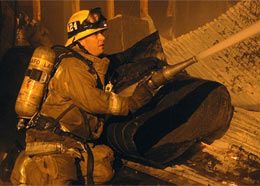By Richard C. Maddox
 Photo Mike Meadows A Los Angeles firefighter mounts a defensive attack at a commercial building fire in December last year. |
For 270 years, the U.S. fire service has enjoyed a long history of saving lives and property no matter what. But the cost of this has been 100-plus firefighters’ lives annually and the subsequent burden placed on their families.
Firefighters can easily tell you when to engage in an aggressive interior attack — but most cannot explain when the attack mode should change from aggressive (offensive) to defensive.
Several organizations and departments publish “rules of engagement,” including the IAFC’s safety, health and survival section.
At a meeting of the FDSOA’s board of directors, a discussion was held concerning “rules of disengagement.”
The FDSOA agreed on the acronym “AWARE,” which by being simple and easily remembered we hope can help reduce firefighter injuries and deaths.
- Attack progress
- Water supply
- Air supply
- Resources
- Environment
Attack progress
Are we getting the job done for the amount of effort and risk that we’re putting in? How effective are we at “putting the wet stuff on the red stuff?” The interior crew company officers must give the incident commander accurate and timely reports on the fire conditions and the progress being made (or not made). The IC must take the individual reports, put them into the overall incident view and decide if they match the incident as they see it. If the reports are conflicting, then the IC must make the best decision that protects firefighters. Company officers must evaluate efforts and abandon the idea that their crew will be ridiculed if they don’t “tough it out.” Lack of progress on fire attack or increasing amounts of fire should result in the immediate disengagement of interior crews. Deteriorating conditions or conflicting reports should result in disengagement of interior crews.
Water supply
No interior operation should begin until an adequate, maintainable water supply has been established. Pre-incident planning helps locate primary and secondary water sources. The water supply should meet the needed fire flow of the incident. The National Fire Academy fire flow formula is a good reference for this calculation. Company officers must select the size of the initial attack line depending on the fire conditions: the “Big fire, big water” concept. Back-up lines, of course, should always be in place. The engine chauffer needs to monitor incoming water supply and immediately report any changes. The use of flow meters allows the chauffer to monitor the operation of individual hand lines better than pressure gauges when monitoring outgoing water. Significant decrease in water supply should result in immediate disengagement of interior crews.
Air supply
Firefighters should be taught air management techniques and should have SCBA operations mastered before being allowed to engage in interior operations. Any SCBA problem or failure should result in the immediate disengagement by the entire crew involved. Company officers should monitor their crew air supply and the IC should have an accountability system that allows for the monitoring of time that crews are “on air.” An adequate refill capability and spare air bottles are needed for long duration incidents. Inadequate air supply should result in the immediate disengagement of interior crews.
Resources
Adequate staffing and equipment determine the outcome of the incident. Lack of either will have a negative impact on results. “Two in and two out” is just a starting point for resource evaluation. Resources must be available to initiate and maintain interior operations. Lack of staffing or needed equipment should result in the immediate disengagement of interior crews.
Environment
Under what conditions are the firefighters operating? Has the structure weakened due to fire conditions or partial collapse? Is this a contents fire or a structure fire? Have weather conditions added to the instability of the structure. Have the crews been operating without adequate rehabilitation? Each firefighter should evaluate their personal environment (sleep depravation, alcohol use within eight hours, etc). Any change in environmental conditions of the building or crews involved should result in the immediate disengagement of interior crews.
Firefighters are by nature aggressive, goal-oriented individuals. The decision to disengage from aggressive operations is not an easy one, and one that will not be well received by the crews. But when considered, firefighter safety should be the primary goal of the immediate disengagement of interior crews.
 |
Richard C. Maddox is the vice chairman of the Fire Department Safety Officers Association. He is a certified fire suppression incident scene safety officer and a health and safety officer. He has served with the Sayville, New York Fire Department for the past 32 years and is currently the department’s health and safety officer and chairperson of its health and safety committee. He is the FDSOA current representative to the NFPA 1720 Technical Committee. Mr. Maddox holds an associate’s degree in applied sciences, a bachelor’s degree in health care administration and a master’s degree in public administration. He is employed by the New York State Office of Mental Health as a clinical risk management specialist. He can be reached at Safetysfd@aol.com











